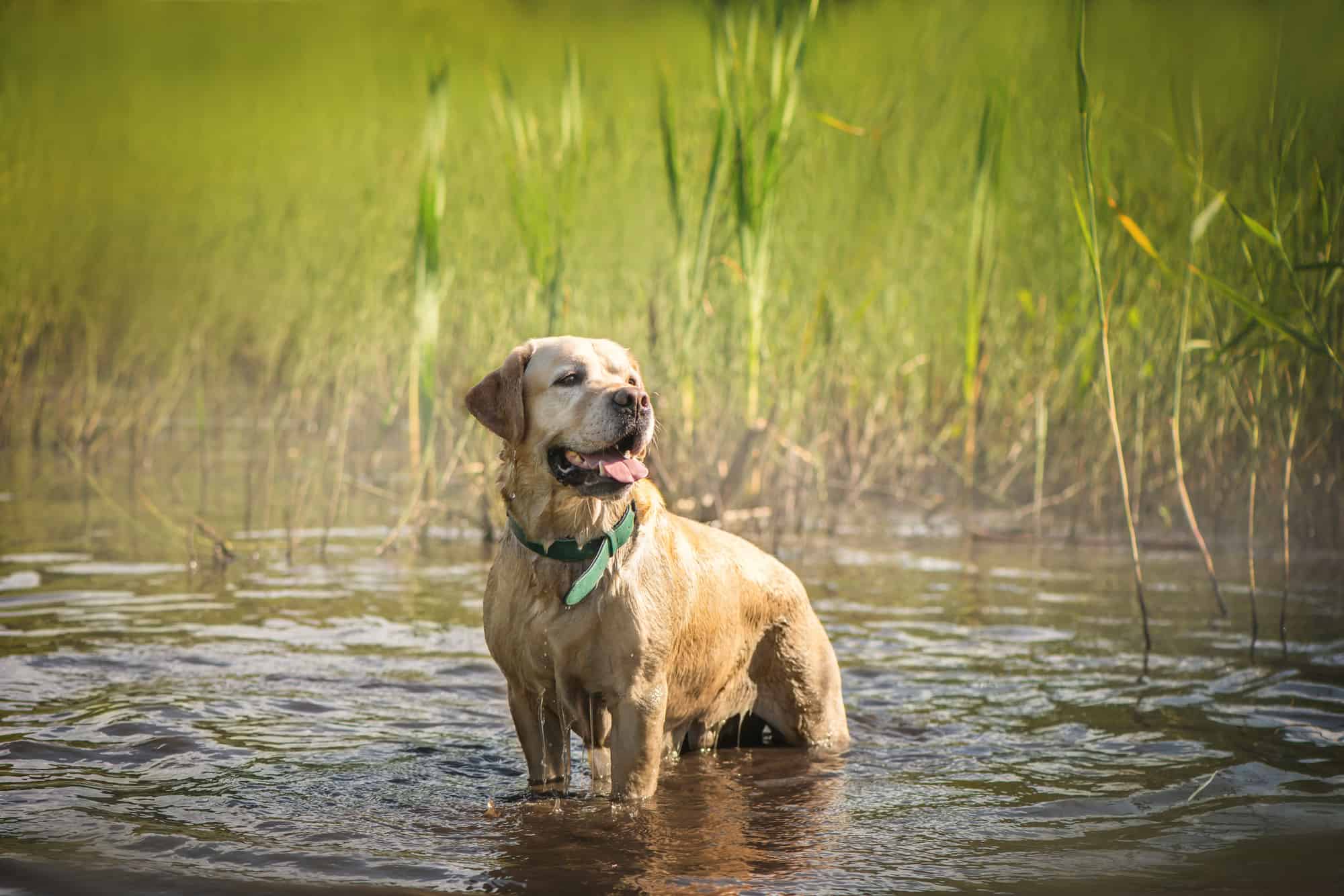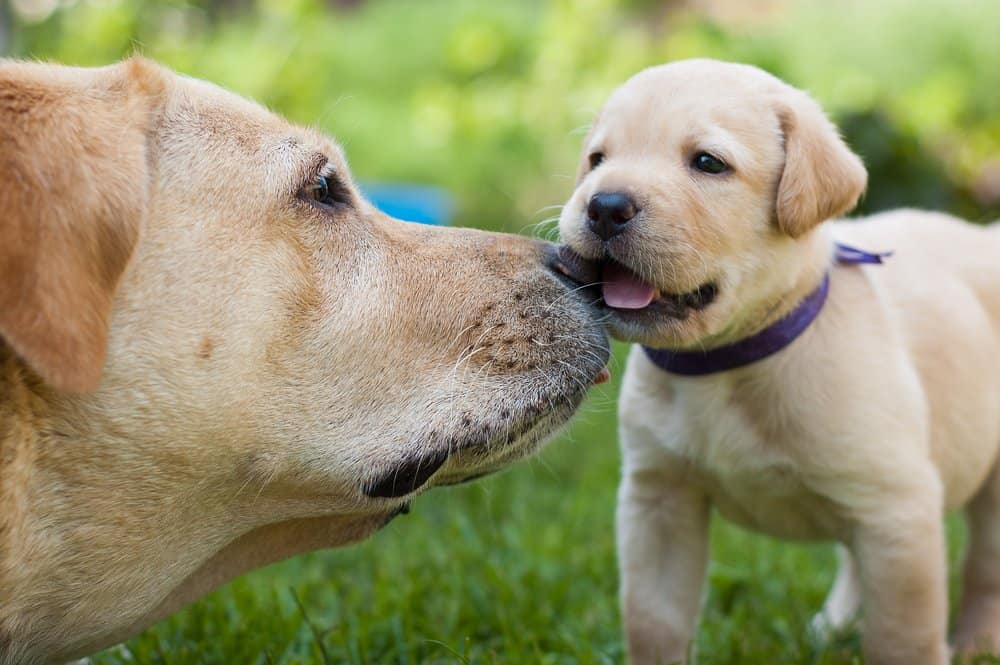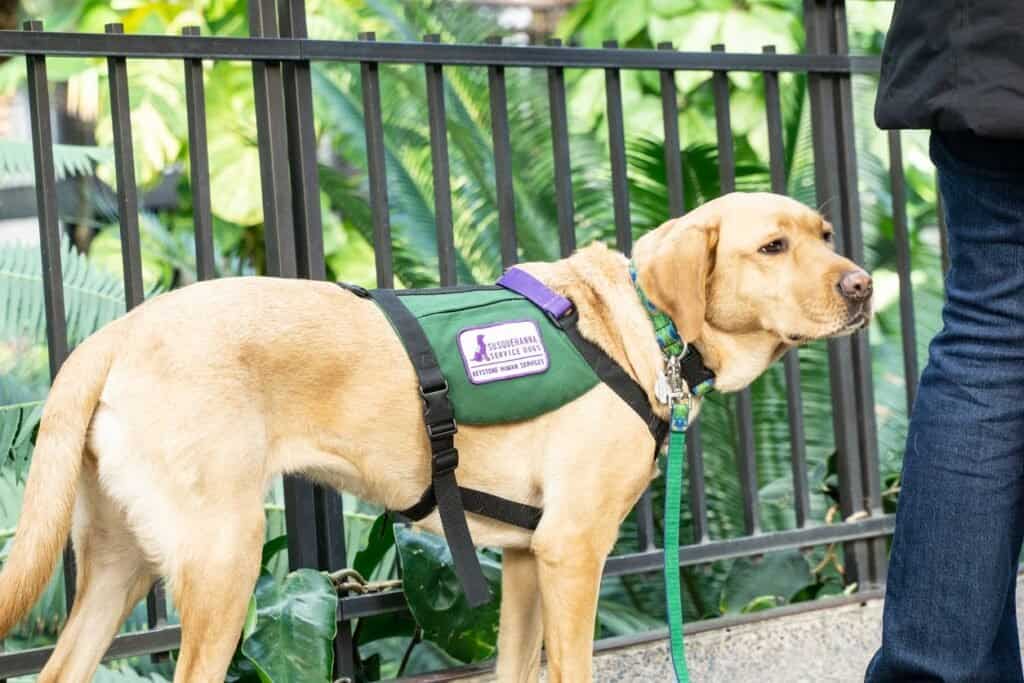The Labrador retriever is one of the most well-known dogs around! Their goofy and gentle nature makes them wonderful for families with kids, and their loyalty to those they love makes them a one of a kind companion. This is likely why they have held the title as the most popular dog breed in the U.S. for over 30 years.
Not only are they one of the best family pups around, but they are known to fill a few life-saving roles as well. Labrador retrievers often work in search and rescue, in drug detection, and in service to those who are disabled. With these impressive qualities in mind, it’s no wonder so many people want to welcome a Labrador retriever into their home! Before doing so, responsible adopters will want to learn the Labrador retriever progression.
With so many dog lovers interested in adopting a Labrador Retriever, we want to make sure you have the tools needed to be the best Labrador parent ever! In this article we will discuss the Labrador’s growth progression, training tips, health complications, and so much more!
Let’s get started!
Brief Labrador Retriever Summary

The Labrador retriever is known for being incredibly friendly, playful, and kind-natured.
©iloliloli/Shutterstock.com
The Labrador retriever was originally created in Newfoundland to be a fisherman’s ultimate companion. They spent their days catching fish that had escaped from hooks and nets. But other locals began to take notice and think of ways this pup could help them as well. It wasn’t long before the Labrador retriever was the ultimate hunting dog. Their incredible retrieving skills are still utilized to this day.
In addition to their impressive skills, the Labrador retriever is also incredibly friendly, playful, and kind-natured. The Labrador retriever makes a wonderful companion to families of all kinds.
Labrador Retriever Growth & Weight Chart by Age
If you plan to adopt a Labrador retriever, then you will want to know how big they grow. Every Labrador retriever will vary, but we can offer you some averages on what to expect!
| Age | Male Weight | Female Height |
|---|---|---|
| Birth | About 1 pound | About 1 pound |
| 1 Month | 4-8 pounds | 4-8 pounds |
| 6 Weeks | 5-10 pounds | 5-10 pounds |
| 2 Months | 10-15 pounds | 10-15 pounds |
| 3 Months | 20-30 pounds | 15-25 pounds |
| 4 Months | 30-40 pounds | 25-35 pounds |
| 5 Months | 35-45 pounds | 30-40 pounds |
| 6 Months | 40-55 pounds | 35-45 pounds |
| 7 Months | 50-60 pounds | 40-50 pounds |
| 8 Months | 50-65 pounds | 40-55 pounds |
| 9 Months | 55-70 pounds | 45-60 pounds |
| 10 Months | 55-70 pounds | 50-60 pounds |
| 11 Months | 60-75 pounds | 55-65 pounds |
| 12 Months | 65-80 pounds | 55-70 pounds |
| 2 Years | 65-85 pounds | 55-75 pounds |
The size of your Labrador retriever will vary based on their genetics. The best way to estimate adult size is by meeting the dog’s parents!
When Will My Labrador Retriever Stop Growing?
Congratulations on becoming the proud parent of a Labrador retriever puppy! You’ll surely want to know when you can expect your puppy to reach adult size. Labs grow significantly throughout their first year of life. This may cause you to wonder when all the growing will come to an end!
Labrador retrievers mature quite fast for a large breed dog. You can typically expect your Labrador to stop growing by the age of two. Many will even reach their adult size by the time they reach one year of age. But they may just fill out slightly in the following year.
How Big Will My Labrador Retriever Be When It’s Fully Grown?

The average Labrador will weigh anywhere from 60-80 pounds.
©Parilov/Shutterstock.com
As we discussed above, many Labrador retrievers will continue to grow until they have reached two years of age. There may be slight differences in size when it comes to male and female Labrador retrievers. But the average Labrador will weigh anywhere from 60-80 pounds.
Though this is the average to keep in mind, it’s important to remember that dogs vary based on genetics. The most accurate way to estimate your Lab’s adult size is by meeting their parents.
The Biggest Labrador Retriever in History
You won’t often find a Labrador retriever that exceeds 80 pounds. But there is one pup in Australia that tipped the scales! There was a Labrador retriever named Samson in 2011 that weighed more than anyone thought possible, and he came in at a whopping 187 pounds!
It’s important to keep in mind that while Samson may have set a weight record for Labrador retrievers, it was due to him being massively overweight. His story gained traction because he was rescued from a home that did not have his best interest in mind, and they were feeding him an unhealthy amount of fatty human foods.
He was rescued by a family that put him on a weight loss journey, so we hope that with his new family on his side, he went on to live a healthier life! Want to learn about the biggest dogs on record? Click here!
When Should My Labrador Retriever Stop Eating Puppy Food?
If you want your Labrador retriever puppy to grow big and strong, then you will need to feed them a vet approved puppy diet until they have reached maturity. Puppy food is packed with essential ingredients that a puppy needs to thrive, as well as extra calories per cup that keep up with their daily energy requirements.
Since you will need to offer your Labrador retriever puppy food until they reach maturity, we recommend feeding them puppy food until they have reached 12 months of age. Though your Lab may still fill out in the following year of their life, they will have completed the majority of their growth at this point. Once your canine friend has reached 12 months of age, then you can transition them over to an adult kibble made for large breed dogs.
When Will My Labrador Retriever Start Losing Teeth?
Your dog may not be visited by the tooth fairy, but they still lose their baby teeth as they grow into adulthood! Your Labrador Retriever puppy will start to grow their baby teeth at around three weeks of age, and they should have a full mouth of baby teeth by the time they are six weeks old. These are the sharp teeth that you feel gnawing on your fingers at any given opportunity!
Once your beloved Lab puppy reaches 12 weeks of age, their adult teeth should begin to erupt from their gums. This process will push out their baby teeth as the permanent teeth grow in, causing them to lose their baby teeth one by one. Your pup will continue to lose their baby teeth as the months go by, but they should have a full mouth of permanent teeth by the time they reach six months of age.
When Should I Start Training My Labrador Retriever?
Though the Labrador retriever is known for being kind-natured, this does not mean they can pass on obedience training. In addition to being the goofy and lovable Labs we adore; they are also highly intelligent. For this reason, they require diligent obedience training to keep them out of trouble!
No matter how old your Labrador retriever is when you welcome them into your family, we suggest beginning their training from the moment they enter your home. Whether you adopt a 10-week-old puppy or an adult canine friend, you will need to jump into a training program from the start. This will help to ensure that you have a well-rounded Labrador pup to call your own.
Just keep in mind that while obedience training is essential, socialization is just as important! A training program that involves basic command training and socialization to new people and pets will set your Labrador retriever up for success!
What Commands Should I Teach My Labrador Retriever First?
With a canine friend as goofy as the Labrador retriever, you will want to offer them a well-rounded training routine to promote ideal behavior. All large breed dogs should have a good grasp on a few basic commands, as this will help to ensure that you have a safe furry friend in your home!
Here are a few basic commands that we think all Labrador retriever puppies should learn!
- Sit
- Stay
- Come
- Lay down
- Drop it
Not only should you teach your Labrador retriever the commands we listed above, but you should also prioritize socialization. Proper socialization for Labs will involve introducing them to new people, allowing them to meet new dogs, and exposing them to unfamiliar sights and sounds. While the Labrador retriever is known for being friendly, they can still develop aggression and fear if they are not socialized properly.
While introducing your Lab to other dogs is critical, we do not suggest allowing your Labrador puppy to interact with unfamiliar dogs until they are fully vaccinated against canine distemper and parvovirus. You can still take them to public settings and walking trails once they have had their second round of puppy shots, but we suggest waiting until they are fully vaccinated (3 rounds of vaccines) before they meet unknown dog friends.
When Should My Labrador Retriever Be House Broken?

Most Labrador Retriever puppies will be completely house broken within
three to five months of their potty training being implemented.
©cynoclub/Shutterstock.com
One of the most dreaded aspects of training a puppy is teaching them how to go potty outside. Many Labrador retriever parents will wonder just how long it will take to house break their puppies, especially if you ever get frustrated throughout the process.
While every dog will vary, most Labrador retriever puppies will be completely house broken within three to five months of their potty training being implemented. Your pup may even catch on faster, but these averages show you just how different every dog can be. We know how frustrating potty training can be, but your Labrador retriever will catch on soon!
When Should My Labrador Retriever Be Spayed or Neutered?
If you do not plan to breed your Labrador retriever, then spaying and neutering is a great plan for their overall health. Not only will sterilizing your canine friend prevent unwanted pregnancy, but it can also decrease their risk of developing life-threatening reproductive infections and cancer.
While we know that spaying and neutering promotes a long and healthy life in our beloved pups, the best age to sterilize a dog is still up for debate. While you may see conflicting information on the topic, most veterinary professionals agree that spaying or neutering your Labrador retriever between the ages of six to 12 months is ideal.
Just remember every dog has different needs based on their health status, so we suggest following your vet’s guidance on when it’s time to spay or neuter your Labrador retriever.
When Will My Labrador Retriever Calm Down?
Labrador retrievers are known to be extremely goofy and playful, so you may wonder just when your beloved pup will start to calm down. While there is nothing cuter than a playful Labrador puppy, their hyperactive natures can be challenging as they grow into adulthood.
Energy levels will vary from dog to dog, but most Labradors will begin to calm down around three to four years of age.
Common Health Issues Your Labrador Retriever Might Experience
Most Labrador retrievers will live a long and happy life at your side, but there are a few health conditions you should be on the lookout for. All dog breeds are predisposed to certain health complications, and our beloved Labs are no different.
Some of the most common health issues seen in Labrador retrievers include:
Obesity
Labrador retrievers are incredibly food driven, so they are highly prone to obesity. It’s estimated that over 60% of Labrador retrievers are obese, proving just how common this issue is. Not only can obesity make it much more challenging for the Lab to get around each day, but it also puts them at risk of other dangerous health complications. Excess weight can increase the risk of painful joint disease, cardiac disease, diabetes, and more.
Joint Disease
Labrador retrievers have an increased risk of developing painful joint disease. This includes issues like hip dysplasia, elbow dysplasia, and arthritis as a result. Each of these complications can make the dog’s life more challenging and can eventually decrease their quality of life. Some of the most common signs of joint disease include joint stiffness, limping, difficulty getting up and down, hesitance with physical activity, muscle wasting in the hind end, a change in gait, and joint swelling.
Ear Infections
The Labrador’s love of water and their droopy ears combined increases their risk of developing painful ear infections. Some of the most common signs of ear infections in Labs includes head shaking, pawing at the ears, ear odor, ear redness, crusty ears, and crying out when their ears are touched.
Gastric Dilatation Volvulus (GDV)
Labrador retrievers have an increased risk of developing GDV due to the shape of their chests. GDV, or bloat, refers to the condition in which the dog’s stomach flips on itself, ultimately trapping the stomach contents and blocking the blood flow to and away from the stomach. This condition is fatal, and all dogs require urgent veterinary care to save their life. The common symptoms of GDV in dogs include retching but being unable to vomit, severe weakness, abdominal distension, pale gums, and collapse.
Cardiac Disease
Labrador retrievers have a higher risk of developing cardiac disease due to the prevalence of cardiac abnormalities. This is most common in Labs over the age of five, and the common symptoms include coughing, exercise intolerance, weakness, labored breathing, and abdominal swelling.
Not all Labrador retrievers will struggle with the health conditions we discussed above, but it’s always best to be on the lookout for their development!
Pictures Of Labrador Retrievers as Puppies

A Labrador retriever puppy is tiny and adorable!
©Anesssa/Shutterstock.com

Labrador retriever puppies are often gangly little things!
©Odua Images/Shutterstock.com
Pictures Of Labrador Retrievers At 6 Months

A Labrador retriever will have grown significantly by six to eight months of age.
©Dora Zett/Shutterstock.com
Pictures Of Labrador Retrievers as Adults

An adult Labrador retriever is a big dog!
©Judal/Shutterstock.com

Some Labrador retrievers are service dogs.
©iStock.com/arlutz73
Are you ready to welcome a lovable Labrador retriever into your family?
How Much Does a Labrador Retriever Cost?

A chocolate labrador costs more than a yellow or black one, given its less common.
©REN Photography/Shutterstock.com
If you are not yet the proud owner of a labrador retriever but are considering becoming one, it’s advisable to count the costs.
On average, labrador retrievers cost $1,000-$2,000 if you go through a breeder. A chocolate labrador would average higher because it’s not as commonly available. A shelter lab would be less expensive, averaging $100-$300. Food costs average $50-$80 monthly, and grooming can range from $0 (if you purchase your own grooming equipment and do it yourself) to $50 a month.
The more costly factor is medical costs, which average $100-$300 for wellness visits, which are recommended 3-4 times yearly. Treatments for illnesses would run higher. Spaying or neutering costs average $150-$300, and vaccines are $25-$75.
The photo featured at the top of this post is © sanjagrujic/Shutterstock.com
Ready to discover the top 10 cutest dog breeds in the entire world?
How about the fastest dogs, the largest dogs and those that are -- quite frankly -- just the kindest dogs on the planet? Each day, AZ Animals sends out lists just like this to our thousands of email subscribers. And the best part? It's FREE. Join today by entering your email below.
Thank you for reading! Have some feedback for us? Contact the AZ Animals editorial team.






